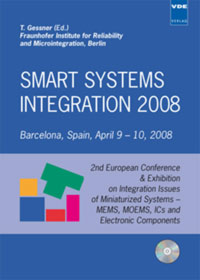Fully-Integrated wireless CMOS smart sensor
Konferenz: Smart Systems Integration 2008 - 2nd European Conference & Exhibition on Integration Issues of Miniaturized Systems - MOMS, MOEMS, ICS and Electronic Components
09.04.2008 - 10.04.2008 in Barcelona, Spain
Tagungsband: Smart Systems Integration 2008
Seiten: 8Sprache: EnglischTyp: PDF
Persönliche VDE-Mitglieder erhalten auf diesen Artikel 10% Rabatt
Autoren:
Segura-Quijano, Fredy; Sacristán, Jordi; García-Canton, Jesús; Oses, Teresa; Baldi, Antonio (CNM-IMB (CSIC), Campus UAB, Cerdanyola, Spain)
Inhalt:
IDE (interdigitated electrodes) or 4 electrode arrangements can be used as impedimetric sensors when placed in an appropriate medium. This kind of sensors can be used to monitor transient food condition by measuring the impedance changes. Other applications can be found in the biomedical field such as monitoring the ischemia injury or the concentration of certain ions. Most of these impedimetric sensors are passive, but in some applications can be interesting to integrate an intelligent circuit to measure the real or imaginary part of the impedance in a frequency range. The more typical configuration to measure impedance of a media is the 4-electrode method, in which 2 electrodes inject the current into the media and the other 2 measure the voltage drop. An instrumentation amplifier that register a differential signal (voltage drop) and an AC coupling to eliminate any offset from the sensor must be implemented to obtain the measure. Additionally, in some applications when the sensor is not accessible, i.e. in a biomedical implant, inside a package or in a dangerous environment, it is important to consider the power supply mechanism. A remote powering using an inductive link [6] can be an alternative, nevertheless in this case it is important to consider that the efficiency in the energy transmission is low. For this reason, power consumption is the most important parameter to be optimized in the design.


